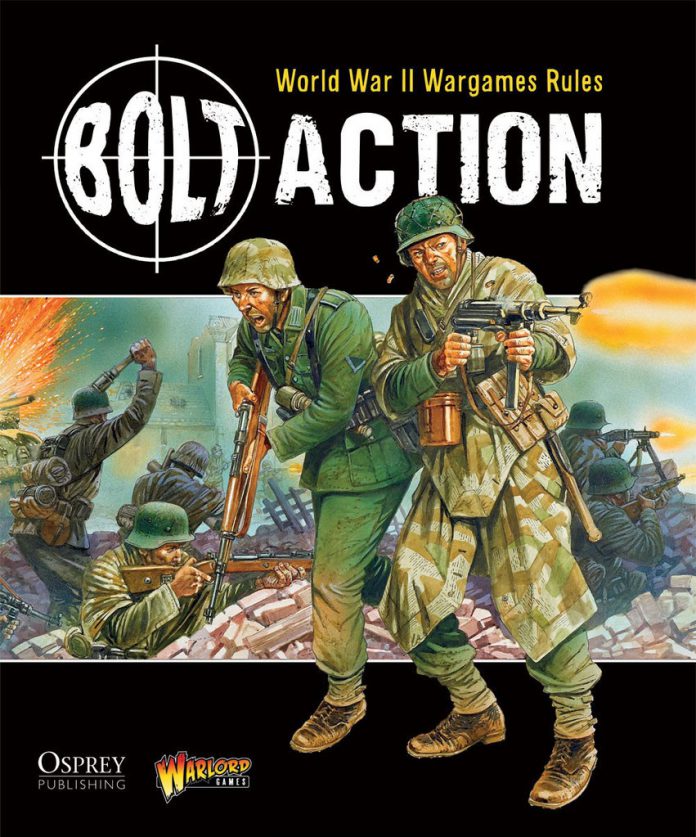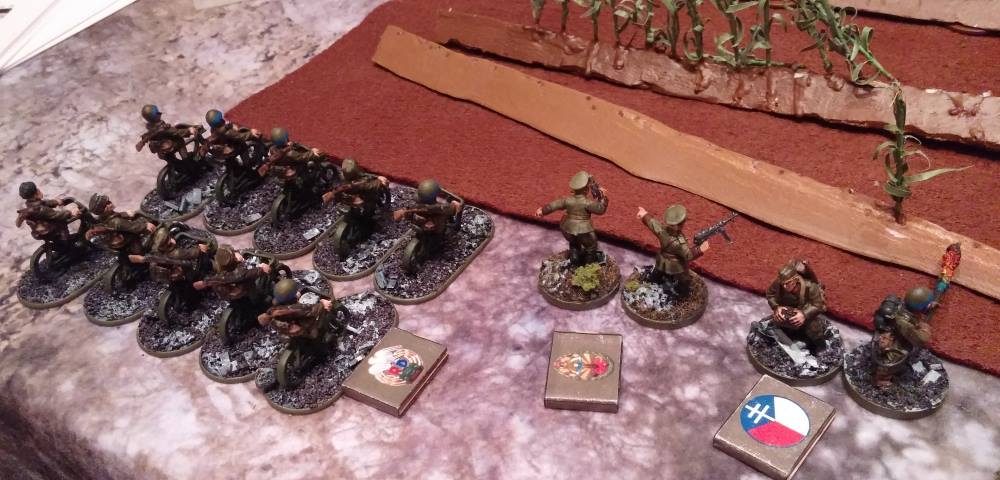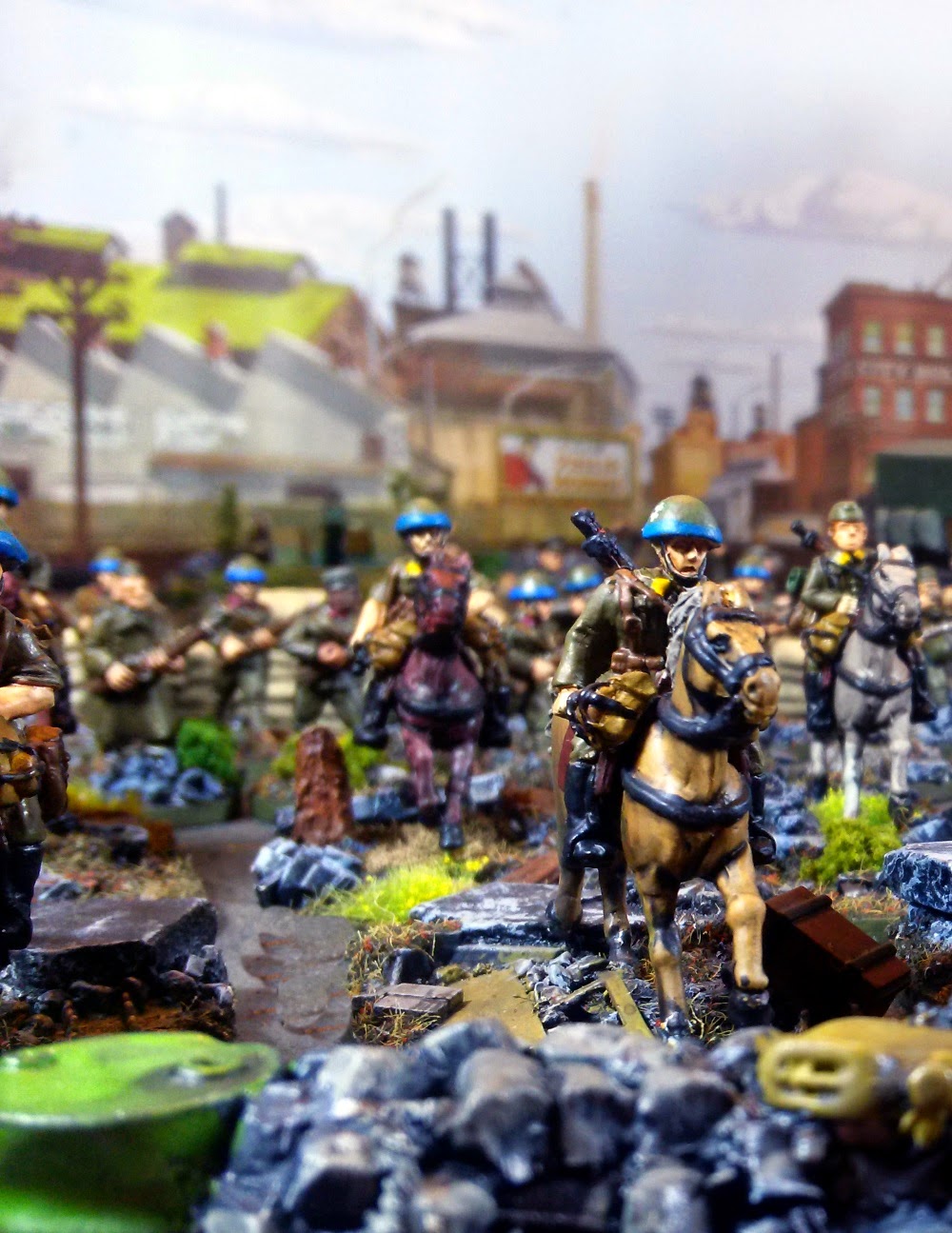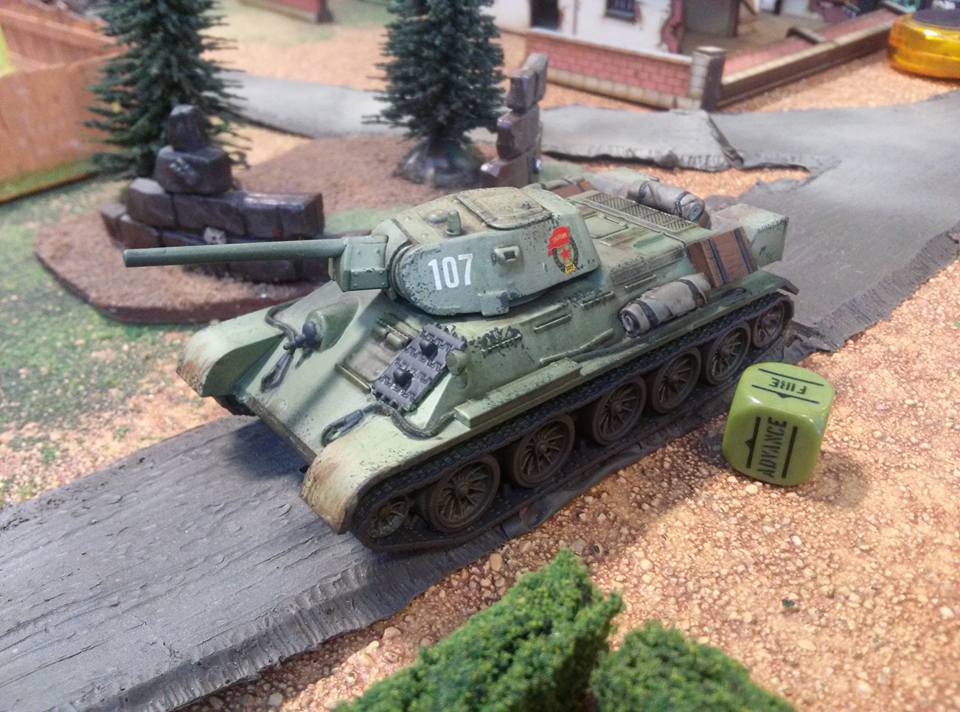So the title of this article probably gives some of the game away, but what is Bolt Action?
Ilor: Bolt Action is a tabletop wargame set in the Second World War. It simulates tactical actions at roughly the platoon level, with a randomized unit activation order that can make for some very interesting interactions between the players’ forces. It aims to provide a balanced framework that supports both historical scenario-based play as well as competitive tournament play.
Mugginns: To go a little more in-depth, Bolt Action is a matched-play game where you can build a force using points, usually around 1000 to 1250 at the largest end. The infantry game (there is a Tank War supplement but most people play infantry vs infantry) is based around the concept of a ‘reinforced platoon’ – a platoon of infantry plus what you’d like to sprinkle in – you can bring weapons teams like Medium Machine Guns, Sniper Teams, Flamethrowers, Mortars (light, medium, heavy), Artillery (again, L/M/H), one armored car, one tank, etc.
There are absolutely tons of different troop combinations and lots of lists for smaller powers like Finland, Belgium, Bulgaria, etc. To me, the key concepts that really latched me onto the game are:
- Random alternating activations using Order dice
- No saving throws
- Historic lists
- Pin markers as morale
- Value for your money
Random activation sounds neat, I really like how it works in Star Wars Legion with order cards and then your own blind bag, is it similar to that?
Ilor: Kind of. Each of your units gets an activation die, and all activation dice for both players are put into a bag. You blind-draw the dice from the bag – if it’s one of yours, you use that die to activate a single unit of your choice that has not already activated (there are six possible orders you can issue, so you just put the die next to the unit with the order you want to give it showing face-up). If it’s one of your opponent’s dice, they do the same. This means you might get lucky and activate multiple units in a row before your opponent can do anything about it – or you might fall victim to being on the receiving end of such a run of opponent’s dice. You keep drawing until the bag is empty, which signals the end of the turn. It nicely breaks up the IGOUGO nature common to most wargames, and means the amount of time you have to wait for your opponent to finish blasting you is much shorter than something like 40K.
Mugginns: To expand on that, there are six different orders:
- Fire: fire at full effect without moving.
- Advance: move, then fire.
- Run: move at double speed without firing, or assault enemy troops in CQC.
- Ambush: do not move, do not fire, but wait to shoot at something in your front. Essentially overwatch.
- Rally: do not move, do not fire, remove D6+1 pin markers.
- Down: do not move, do not fire, -2 to be hit in ranged fire.
When you get shot at by enemy troops, if they get at least one hit, you take a pin marker (sometimes maybe more depending on special rules). This is simulating the suppression of combat. When you go to activate that unit using an order die, you roll 2D6 and compare it to your Morale (Inexperienced troops are 8, Regular are 9, Veteran are 10). You add the number of pin markers to your roll. If it is greater than your morale value, you do nothing and go Down. If you roll a 2 you remove extra pins. If you pass you can do stuff and remove 1 pin.
When you go to do stuff, if you have pins, it makes it harder to do said stuff. If you’re shooting and have one pin, you subtract one from your rolls. So a 3 becomes a 2, 2 becomes 1, etc.
This morale mechanic really sets the game apart from other platoon sized games I’ve played. I really like how you have random alternating activations so you don’t just get blown off the board in one turn.
What sort of size game is it, how big a space do I need if I’m just getting started?
Ilor: As a “platoon scale” game, your average force is generally going to be on the order of 30-50 men, along with maybe a couple of vehicles. The “standard” table size is generally a 4-foot by 6-foot table, but you can definitely play smaller (or larger!) games. When you’re just getting started, there’s no reason you couldn’t set up a very engaging game on your ordinary kitchen table.
But in terms of the amount of miniatures you need, there’s good news here. Though I sometimes rag on it because of this (as it can lead to wildly ahistorical army lists), one of the strengths of Bolt Action is that every unit in the game has some points cost and your force is made by putting together an army list up to some limit agreed upon with your opponent (or specified by your event organizer). This means that Bolt Action is actually really flexible in terms of the size of game it can support. If you want to game out a very small action, just play at a lower points value. For a massive, sweeping engagement, go for big points!
Just be aware that different sizes of engagements (in terms of the overall points available to each player) will have a few ramifications, especially when it comes to the number of activation dice you’ll have available to you. But in terms of ease of entry, you can actually start playing with relatively few miniatures.
Mugginns: llor hit it on the head with most of that – the other thing to take into account is what morale level force you want to play with. Most lists I see are either veteran or regular. A regular trooper with a rifle costs 10 points for most armies, unless they have special rules. A veteran is 13. So if you choose vets you’re going to have squads of six or seven guys at the most, usually, whereas regulars can be eight or more.
The other great thing is that when you’re looking at getting troops, plastic and even pewter WW2 models are very affordable. You’re usually looking at $1.50 to $2.00 per dude. You round that out with a $30-40 tank, armored car, etc. and some weapons teams and you easily have an army under $200.
And what about once I have a couple of forces together at that starter size, how big is the next step up?
Ilor: That’s the beauty of it being based on points – you can increase the size of the game you’re playing at whatever pace you like.
And there’s another trick you can play when it comes to the cost of your forces: because Bolt Action has three different troop qualities (inexperienced, regular, and veteran), you can vary the overall cost of your army list by simply changing the quality of your troops. For instance, a historically-accurate mid-war American infantry squad with an NCO and 11 men (with the NCO carrying an SMG and one of the men in the squad equipped with a Browning Automatic Rifle) costs 92 points if inexperienced, 128 points if regular, and 164 points if veteran. That’s a pretty big swing, and can help you expand the “size” of your game without adding any miniatures.
Or you can paint a single Churchill Crocodile tank and add 485 points to your army in an afternoon. So if your friend rocks up to the table and wants to play with that brand new tank she just painted, you can counterbalance that increase in points by making all of your troops veterans or whatever.
Mugginns: I’m playing in the Combat Patrol event at AdeptiCon here in a few days and I’m running somewhat of a non-newbie snowflake list. At 450 points I have:
Slovak Fast Division in 1941 Patrol
Second Lieutenant on Horse
8 Infantry on Bicycles with Rifles
8 Infantry on Motorcycles with Rifles
8 Infantry on Horse with Rifles
1 Light Armored Car
So that’s definitely a weird way to start an army – I would look at a plastic box of troops for sure. My advice would be to have at least four squads of infantry with seven dudes in each. Grab a weapons team – my favorites are medium mortars and snipers. Then get a tank of some sort, whatever you like. I prefer light tanks as they’re fewer points but they usually are less armored and their guns aren’t as big.
I would definitely recommend checking out Chicago Dice’s guide here as to how the starter boxes break out.
So extrapolating out, it sounds like 500 points is a smallish game, and moving up to 1000 points would be a more standard size? Are there any army builders I can take a look at to play with some lists?
Ilor: For making army lists there are two nice options right now. Battlescribe supports Bolt Action and is a tool with which lots of people are already familiar. I find the interface a little clunky, but I was able to make it work. But I think the EasyArmy website (https://wg.easyarmy.com/BoltAction) is a nicer interface. It also makes it much easier to sort army list types and see which sourcebook a list comes from.
Mugginns: I would say at this point in the game’s life that the standard tournament is 1250 points. This provides a little buffer so you can bring veteran troops and bigger tanks. For reference, a Panzer IV H, what I would consider a standard mid-war or late-war line tank, is 235 points regular. If you go bigger, say a Panther D, that goes all the way up to 355 points. An M4A1 75mm Sherman is 195 points regular. I just provide these so you can see where the totals are coming from.
When I usually put together a list for my early war Slovaks (I use the German list) I include a Panzer 38t, medium mortar, medium artillery piece, sniper team, light armored car, and anti-tank rifle team. That comes out to 405 points. The rest is infantry, leaders, and trucks if I need them.
Easy Army is definitely the go-to for building your list and it makes it really easy. It provides printouts that make gameplay easier as well with morale values, AT values, armor values, etc.
I know there’s probably a huge range of models, but any recommendations on what to buy to begin with?
Ilor: Oh, man, this is such a can of worms. I think you really need to start by deciding what nationality you want to play. The choice here matters in terms of what forces you’ll even have available to you. Then you’ll need to give some thought to what era of the war you want to model. This again has ramifications for what you buy (and how you might paint it, see below). If you’re playing with an early war British East Africa list, your choice of tanks or armored cars is vastly more limited than if you’re playing a late war British list from the Normandy landings. Do you want to play more run-of-the-mill infantry, or do you want to go hard and play paratroopers?
Another way to pick a force is if you have a family connection to something. My grandfather served as a medic in the Rainbow Division in WW2, for instance, so I might model my starter army on that to give it a personal touch. Mugginns’ Slovak Fast Division is a similar ancestry/family connection project, and that army is rad as hell because it is both unusual and intensely personal.
Barring that, you can just pick a force you think looks cool. In terms of painting and modeling projects, I find that working on something that you personally find aesthetically pleasing is usually a great motivator!
There’s another important consideration here as well, and that is the manufacturer from which you purchase your miniatures. While Warlord Games (the publisher of Bolt Action) has a fantastic range of available units and vehicles spanning the entire war, you don’t have to use their miniatures to play the game. I know this might seem shocking if you’re coming from a sci-fi or fantasy tabletop gaming background, but for historical games like Bolt Action you have a mind-bending array of options for your figures. For my infantry, I have troops from Perry, Black Tree, Wargames Factory, and Gaddis Gaming. It wasn’t until my fifth combatant army that I finally picked up some Warlord infantry. For vehicles or artillery, I have Warlord, Rubicon, Perry, and a couple others I’m almost certainly forgetting.
One thing to be aware of, however, is that different manufacturers have slightly different ideas about what “28mm scale” means. Warlord figures tend to have chunkier, more “heroic” proportions than Perry miniatures (which are more realistically proportioned and thus comparatively spindly), for instance. One of the things that you’ll see in almost any review of historical miniatures on the internet is some commentary about which other manufacturers’ ranges they match well with in terms of size or proportion. Sticking with a single manufacturer will simplify this, but depending on the force you’re trying to build (especially for more fringe stuff) that may not be an option.
Mugginns: if you’re used to plastics from GW or other manufactures, I’d recommend plastics from Warlord Games, Perry Miniatures, or Wargames Atlantic. There are tons and tons and tons of pewter minis out there too, and I use them a lot, but if you’re a newbie to pewter it can be a shock.
There are also tons of manufacturers out there for plastic and resin tanks and vehicles. For a comprehensive list check out the Chicago Dice site here.
Alright I’ve got an idea of what I might want to buy, any advice or references for how to paint them?
Mugginns: I scour the web for information, especially for smaller countries like Slovakia, Bulgaria, etc. Really the best source of info are Osprey books. Man-at-Arms, Elite, etc. You can usually find them on Amazon or Ebay for $10. There are also excellent books by Painting War that really offer tons of guidance for Germany, Japan, and USA.
Ilor: I can second the Osprey books, they’re great for illustrations of uniforms and such. And if all else fails, you can usually get pretty far with a Google image search.
I’ve seen some amazing tables for World War 2 games but there seems to be lots of variety. If I wanted to start my own, how much coverage would you recommend?
Mugginns: there are a ton of different theatres and the terrain varies for each. I think a lot of players start off in Europe because there are many armies that fit there – usually a half dozen tree bases, a small town of maybe 3-4 houses, some roads, stone walls and fences are good to get started.
Ilor: I went sort of a different route and started in the desert, because I already had a fair amount of desert terrain. But it generally results in a table that is more open, which can change how the game is played a little bit. If you want to maximize your options then yeah, “somewhere in western Europe” is probably your best bet. But really leaning into a theme can produce some striking tables as well. I’ve always thought that jungle tables looked really cool, for instance.
Have any questions or feedback? Drop us a note in the comments below or email us at contact@goonhammer.com.

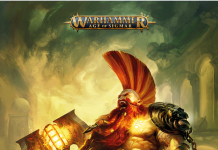
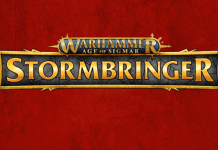
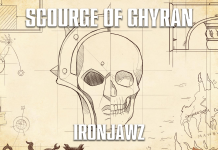
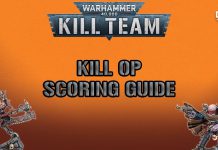

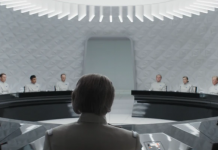
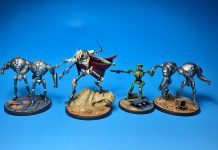
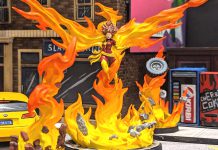
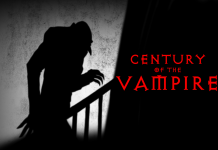
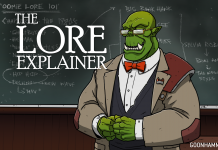
![[40k] Competitive Innovations in 10th: Warping Time pt.2](https://d1w82usnq70pt2.cloudfront.net/wp-content/uploads/2020/01/Analysis_Banner.png)


